Boats like to be used. Boats that are aired with regular use rarely smell. Obviously this poses a challenge for commuter cruisers! Our boats are shut up for six months straight, usually in the hot and humid tropics. Unfortunately when the boat is shut up, the accumulation of human sweat, mold and mildew and diesel fumes can make a pretty powerful stink! We do several things to help miminize the odor cloud that will escape when the companionway is first opened, no matter how diligent we are about cleaning. Despite the previous owner taking great care of our boat, when we bought it, it was already 16 years old, so smells had accumulated. Our initial year of ownership was spent fighting the smell every time we returned to the boat. Now, after owning the boat for over 10 years, it’s 26 years old, but it doesn’t generally smell after the initial re-opening when we return in the fall annually.
When you open the companionway for the first time after a six month absence (or even a couple of months), don’t expect a nice clean smell — give it a day or more to air before you start to worry about smell. Run all fans, get as much air circulating as possible. If you’re running an a/c be sure to run fans too. Before you close all the lockers, air them out more — a portable fan, such as our favorite, port fan from HotWire is perfect to get more air moving inside a closet, inside the bilge, wherever it will reach with it’s 12v cord.
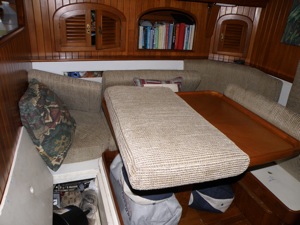
The #1 rule — if the boat smells there’s a reason, a culprit waiting to be discovered and the culprit is likely better at playing hide n seek than you are at finding the source of the smell! Lots of websites, marine retailers and general retailers will be happy to sell you an amazing array of “stuff” designed to cover up the smell, but not necessarily eliminate it. Be wary of these unless you prefer your boat smell like an elderly lady reeking of too much perfume to cover body odors! Others will recommend you run an ozone generator or air purifier in the boat. These may work great, but if you don’t eliminate the source of the odor, it will reappear every time you re-open the boat after being away a bit.
Other hints for minimizing accumulating stink while you’re away:
1. While we’re gone, the dehumidfier minimizes mold and mildew, especially inside. When we return, a good solution of bleach and water washdown wherever I can see mold – generally outside in the engine compartment or cockpit lazarettes – gets rid of the bulk of it. There will always be mold lurking in places I can’t see (or reach), but I do the best I can!
2. While we’re gone, all the locker doors, cushions and even mattresses are askew to allow air to cirulate. It’s important to keep cross ventilation going if at all possible. We have an open dorade on one side of the boat and a solar fan set to suck air out on the other side.
3. It may be an old wives tale, but it makes me feel better to leave bounce sheets under every cushion, on the hangers in the hanging lockers and in the shelves and drawers for folding clothes and stuff. I have no idea if they do anything at all, but the boat seems to do well every summer, so being superstitious, I’m afraid to vary the routine!

10 Tips to Help Rid Your Boat of Odors
1. First, buy Peggie Hall’s book “Get Rid of Boat Odors” – it’s available at Amazon, Armchair Sailor and other reputable marine stores. Although it mostly deals with head odors – Peggie’s nickname is “The Head Mistress” – it also has a small section on making sure you aren’t getting bad smells via the bilge. Plus it tells you anything and everything you need to know about your head and holding tank, including exploded diagrams of several of the most popular brands of heads. For more about the book, click my review post here.
2. The head is an obvious culprit for stink. Every six months I wrap a clean cotton cloth around the sanitation hoses – any hose to or from the head. Leave it for a bit and smell it when it’s removed. If it stinks, the sanitation hoses need replaced. While still in the head, wipe down everything and keep it clean. We also use Raritan’s CP (cleans potties) both to clean the head and also down the drains to keep them smelling fresh. If you have a shower sump, be sure to check it and scrub it out. We don’t have our shower sump hooked up because we don’t take showers below, but this is an easy place for mold and mildew to accumulate so beware!
3. We always use a treatment of some sort in the holding tank – my favorite is Raritan’s KO (kills odors), but a marine head expert in Key West advised us to try Tide — he swears that a cup of Tide in the holding tank will clean it as well as keep it smelling like fresh laundry. We’re trying the Tide but the jury is still out. Another “expert” told us to try Calgon Fabric Softener. When we return to the boat if the Tide doesn’t seem to be doing it’s job, I’ll try Calgon. A big advantage in using Tide is that it’s available everywhere. If you use KO, you’ll have to bring a supply with you to the boat.
3. The bilge must be kept clean and dry. It accumulates any bit of whatever from wherever – in our case, we’re still being punished for the oil that leaked from trying alternatives to changing the oil. OK, so not all of us can totally comply with this “rule”, but if you can, you’ll go a long way toward minimizing stink. Our bilge is small, but too deep to reach, so we use a portable hand bilge pump to suck out as much as we can get.
There are various recommendations for cleaning the bilge ranging from 2 bottles of Joy to Tide to products purchased especially to clean the bilge. We’ve found that none work perfectly but we generally try one or two different solutions every year. Our current favorite is Tide, but I will say the oil stuck to some surfaces down where we can’t reach them, just swipe at them with a rag or a sponge on a stick, is not all cleaned up six years later. The good news is, it doesn’t pump out either, so our dwindling mess remains contained. The other good news is, it doesn’t stink.
4. Food lockers, the refrigerator or ice box must be kept clean. We wipe ours out with a bleach solution whenever we need to defrost the refrigerator freezer.

5. Boat cushions can hide musty smells. When we replaced the original foam settee cushions and the foam mattresses, our boat instantly smelled better. Cushion covers will retain body sweat turning your salon into what might as well be a gym locker room unless you clean the cushions. Even if they don’t look dirty, we wash ours annually and let them air dry so they don’t shrink. Despite the claim that they must be dry-cleaned, when we were out of the US in remote areas, dry cleaning simply wasn’t an option. So I threw one in the washing machine on cold/cold as a test. It worked perfectly so now I do them at the end of each cruising season. If you don’t need to replace the cushion foam, setting it outside in the bright sun uncovered with the cushion covers for an hour or so can do wonders. As a quick perk-em-up, you can also spray the cushions with covers in place with Febreze antibacterial spray and set them out in the sun. I do this after every extended tropical rain.
6. The chain/rode locker. This locker gets smelly muddy yucky every time the anchor goes up. Since it opens directly to the head with a set of louvered doors, the smell can easily make it’s way into the boat. Taking everything out, wiping the locker down with a bleach water solution and air drying it every so often will do wonders. We do ours at least annually as part of our checklist to leave the boat. If it starts to smell before the cruising season is over, we take the chain out on deck and let it dry.
7. The diesel/engine compartment can smell like diesel fumes – YUCK! We wash the compartment walls with a vinegar and water mix – usually equal parts but sometimes more vinegar than water. We keep a 3M sheet under our 26 year old trusty Nanni Kubota diesel to catch any spare drips and change the sheet regularly depending on what’s leaking – monthly if it’s just the usual salt water drip from the stuffing box.
8. We’ve had other cruisers recommend using Superclean by Castrol found at Wal-Mart. Apparently it is biodegradable, inexpensive and works to cut grease and grime but be sure to use rubber gloves. We have yet to try this, but may try it in the bilge if it appears to be safe for hoses.
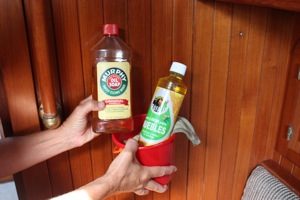
9. The interior teak. I don’t know if it every smells, but usually twice a year I wipe all the interior teak — Winterlude is full of original teak staving that is beautiful, but demands attention. I wash it with a Murphy Oil and water solution according to the instructions on the bottle. Then I use just regular lemon oil to wipe it down again. The lemon oil provides a nice fresh scent. Do be careful though, while in Panama I bought some lemon oil that smelled like some strong antiseptic. Neither of us could tolerate the downstairs until it aired a few days! But the wood looked good! 🙂
Do you have any other ideas on how to keep the boat smelling clean and fresh? Leave a comment please! THX! Jan
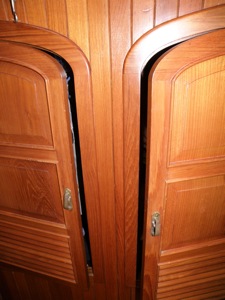
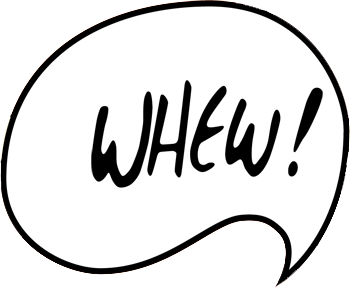
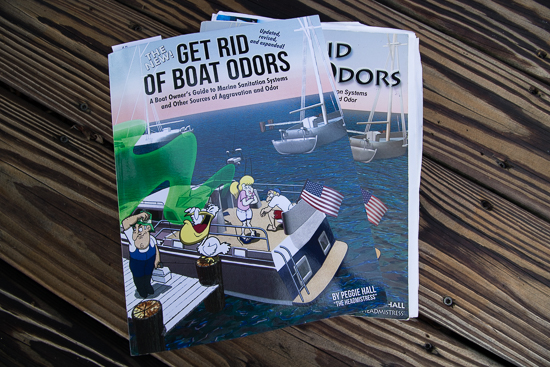











I am glad I am not the only one dealing with boat odors. I do have a helpful tip. I found that using Marine Shocker/A> between cleanings and while in the boat keeps everything smelling fresh.
I’ve read that tea tree oil kills mildew (after removing the visible stuff with bleach water) and have used a solution of 2 cups water to 2 teaspoons tea tree oil, spray on and allow to dry. I used it on the whole boat about 6 months ago and so far so good. You can also spray it into those hard to reach areas.
We have a lingering diesel odour in act cabin after work done on the engine. Not spilt diesel more of a fume type smell. Checked exhaust but not leaks there, so any advice. Ventilation helps but can’t always keep ports open.
When it comes to diesel odors it can be very hard to completely remove them, always need to find the source, but with a Marine Ventilation System you can completely eliminate the odors. Go to the website has lots of good info on ventilation and the benefits
The website is http://www.marineventilationsystems.com
Hi John — does it smell like fresh diesel or exhaust diesel? There is an overflow on a diesel tank – is there a chance that the overflow is routed back toward the aft cabin? If so, is there a chance there’s a tiny pinhole leak in the overflow hose? Other than that – is the odor primarily when or just after the diesel is running or just all the time? Typically after our diesel gets worked on, we have a diesel odor in the cabin but with ventilation it’s bearable and soon it’s gone, but that’s when we’re living there all the time –even when David just changes all the filters and oil, we sometimes get the odor just because the diesel has been running with the housing open, so the salon, galley and quarterberth are all exposed to the odor. When that happens, I assume it’s being absorbed in the upholstery & use Febreze on all the cushions, pillows & even the quarterberth mattress and take the smaller items outside to dry in the sun. I’ll ask around and see if anyone has any other ideas. Bummer, I hate diesel fuel smell, whether it’s fumes or drips. 🙁 I hope you find it & I’ll let you know if I hear anything else. Jan & David
Hi. Finally discovered culprit. The previous owners had the sender changed on the diesel tank and the company that did the job could not find a sender that matched the screw holes on the tank, so they just lined it up best they could and left 2 of the 5 screw holes vacant hoping the gasket would sufficient. Bad, bad boys!!!. Turns out that hen the tank was ful or the vessel on a lean, diesel would drip out the hold and leak into the aft cabin and settle under the 2 squabs. We threw out all the pillows, slips, washed the squb covers and replaced the squbs themselves. We also found a new vertical sender with matching holes which gave us a more accurate fuel gauge as well as fixing leak. Lesson here is…Don’t trust so called professionals do do the right job, Always ask obvious questions, teach them to suck eggs if necessary, that’s what common sense is.. Sense that is for he common people who actually use the vessel.
Useful tip for getting the last of the water out of difficult bilge corners: cheap disposable diapers! They suck the water up and hold it for removal. I always have a few on hand as they store compactly but suck up any spills etc.They can be difficult to dispose of if you’ve cleaned up a fuel spill but if it’s bilge water you can leave them in direct sun for the water to evaporate. Just be careful not to burst a full one …
Great idea Tim! I’m going to try sticking one into the bottom of our bilge when we return to the boat in mid-October! The bottom is rarely dry and always a PITA! Cheers! Jan
REally looking forward to knowing if the Tide works. That would be very convenient.
Look into the Marine Ventilation System it will completely eliminate all odors Mold & mildew from the cabin and bilge.A hole boat ventilation. improving cabin comfort and safety!!
Hello,
We manufacture industrial grade deodorizes for niche industries. We currently have a product called “Boat Fresh” that is used for interior odor removal.
You can read more details about the line at http://www.advancedodorsolutions.com
Regards,
Joe
Molds are part of the natural environment. In outdoors, molds play an important part in nature by breaking down dead organic matter such as fallen leaves and dead trees, etc. But indoors, mold growth should be avoided and prevented. Molds reproduce by means of tiny spores; the spores are invisible to the naked eye (only on microscope) and float through outdoor and indoor air and contaminate areas. Mold may begin to grow indoors when mold spores land on surfaces that are wet or areas with moisture. There are many types of mold, and none of them will grow without water or moisture. So, moisture plays a great part of it.
They attack usually on foods but they also attack non-food items like leather, wood and porcelain. Do you notice your allergic reactions are worse when you’re at home but you feel better when you go out? Well, expect it. If so then it’s especially likely you could have mold. Don’t go weary of staying in one place. Find a way for mold detection
I use oil of cloves diluted in H2O to control mildew. 8 drops to 1 litre. Can be sprayed or wiped on the surface you want to treat. works very well and unlike bleach which just bleaches the mould, clove oil kills the spores. I treat the timber of my boat before it is locked up for the wet season. NIL mould onboard when we return at the start of the sailing season.
Roz — THANKS so much for the clove oil tip! I’ve been looking for something I could spray into places I can’t reach that would kill the mold, preferably without killing ME! Hopefully this is the solution. Cheers! Jan
Hello to All….Odors and Mildew are tough problems to tackle. Iosso Products makes a few products for just those exact problems. The Iosso Mold & Mildew Stain Remover is a powdered product you mix with water. Mix up enough for what you need to clean. It is fabric and color safe so you can apply it to cushions, carpeting bed areas, etc. It has no bleach and is biodegradable so it can be dumped into the water without harming fish or wildlife. It has very little smell when mixed so it is great for people with allergies and leaves no odor behind. It removes mildew stain, tree sap, bird droppings, food & drink stains, pet stains, etc. It does remove lingering odors from the surfaces. You can use it inside the refrigerator, bilge, head, to flush out smelly drains too.
One of the other products we make is called Odor Buster. If you know the source of the odor it should be sprayed directly on it. Furniture, cushions, beds, or just in the air to freshen. It has no odor and leaves no odor behind. It permanently removes the odor as long as it is not re-introduced. If it is re-introduced, re-spray. Whats nice is that is does work and has no fragrance so it is not masking the odor.
We have other Iosso products that we love. Would love to try these, both in the boat and travel trailer. THANKS for sharing Marianne! Cheers! Jan
[…] How To Get Rid of Boat Odors – Commuter Cruiser — … – 10 Tips to Help Rid Your Boat of Odors. 1. First, buy Peggie Hall’s book “Get Rid of Boat Odors” – it’s available at Amazon, Armchair Sailor and other …… […]
The best treatment for ‘heads’ & holding tank odour is Noflex Digestor made by Gemini Packaging in Vancouver
Thanks Andrew! Any idea where it can be purchased? Cheers! Jan
Here is a link to a map of dealers
https://www.google.com/maps/d/u/0/edit?hl=en&authuser=0&mid=1KuALBdPKo1RtfsehawTf2lu_rBc
Noflex is the best for head smells and cleaning the tank some people use a little in the bilge but just a litle.
Over all boat odors i use sheets and small ac fans to keep air moving and try to keep things dry
I discovered alternatives to javel water to kill mood on our boat. I react not very well to javel vapor, if spilled on wood it remove the varnish and finally it kills mood only on hard surface. I have a few spraying bottles with either a mix of water and vinager (with or without soda), water and tea tree oil that will not discolour wood. For place with no wood I sometime opt for hydrogen peroxide. Vinager smell disappear relatively rapidly. It has the advantage of killing mold on a variety of surfaces, including fabrics.
I bought a boat 5 months ago and learned afterward a previous owner had 3 dogs on the boat and it appears the owner was locking these dogs in a few separate lockers (I assume they were small dogs) rather than gettting a crate to put them in. So the dogs apparently pissed in these cabinets and the odor is intermittently strong or undetectable. One cabinet is teak inside and one is melamine.
I’ve tried straight bleach, vinegar, fabric softener, and a couple of other things, to no avail. The bleach worked the best, keeping the odor at bay for a week, but it is now as strong as ever.
Any ideas?
Wow, what a bummer! 🙁 I would have tried the same things you tried. I asked around with friends on boats that have dogs and got a couple more ideas. Mix a vinegar/water solution with baking soda (depending on how strong you make the vinegar solution, it might react like the volcano I made when I was a kid, but that’s OK). Let it dry and vacuum up any powder residue. Some say use white vinegar, some prefer cider vinegar. I read online to mix some grapefruit essential oil with the vinegar solution, but have no idea if it would help or not. Another idea is hydrogen peroxide – some just pour it in, some make it into a solution. Or here’s another idea I saw online after someone mentioned they use hydrogen peroxide for pet odors … “hydrogen peroxide is used is to make a solution of 5 ounces of peroxide, 1 teaspoon vinegar, 1 teaspoon of baking soda and a half teaspoon of orange dish washing liquid. Add them to a spray bottle and spray over the area. Allow to dry (it will turn to a powder) and vacuum up. Finish by making a solution of 1 cup of baking soda and 6 drops of lemon essential oil. Shake them together well and then sprinkle over the area and leave over night. Vacuum it up in the morning.”
No idea if these will work. If you find something that works for you and want me to share it, please let me know & I’ll do a post on CommuterCruiser giving you the credit.
THANKS & Good Luck! Cheers — Jan
The Mold & Mildew Cleaner from Iosso works well to clean and remove pet stains and odors. Once cleaned spray generously with the Odor Buster. It truly will remove the odor permanently. What is nice about the Odor Buster is that it has no odor itself. Check out our website at http://www.iosso.com
Nature’s Miracle is wonderful at removing all biological stains and orders. It is available in any pet store (I get mine at PetsMart) and comes in a spray bottle for hard to reach places. After over 20 years of dog ownership, this is the only product I swear by! Good luck!
Jan would you mind sharing if #3 worked
Hi Summer! No idea if putting bounce dryer sheets under things and on hangers and in drawers really helped, but our boat never smells musty, so something, or the combination of stuff works. And it’s easy & not expensive. So we’re getting ready to buy a new box of bounce for hurricane season 2016! 🙂 Cheers — Jan
How do I take down the carpet thats on the wall of my 25 ” O day? It has water stains and mold on it
Sorry Terry, no idea. But sure sounds like a good idea to take it down! Ugh! Cheers — Jan
If the carpet is not deteriorated you can try and clean it first with the Iosso Mold & Mildew Stain Remover. It will remove the Mold/Mildew, water stains and odors. Use a carpet cleaning machine to achieve the best results. It helps to get most of the water out.
Use the Odor Buster if there is an residual odor left.
Thank you I’ll try it.
Great tips! I have taken my boat out and it was a challenge for me. The tank was venting putrid odors so bad you could smell it on the dock. Everyone asked me for a solution and I found this article….
The best product for getting rid of smells and helping MSD’s to work more efficiently is ZAAL Noflex Digestor which is available out of UK at jetvac.co and out of N.A. from jetvac.com
For boat cleaning and salt removal try ZAAL Sea Solve.
For more information contact us.
Great tips and cleaning. All of this information really useful for getting rid of the boat odors. I absolutely accept with you. I read so many essential things about your article. Keep it up. I enjoy it.
Great post! 2 questions: the foam used for our salon deters have a strange odor. Could it just be the smell of the actual foam? It’s not a milder or mild smell (I don’t think) and was wondering how to just make them not smell like anything. There is no visible signs of mold or mildew. They are just darkish yellow and are still in good shape. How do you know? I would hate to go through the morons of cleaning just to find out it is an inherent smell to the actual foam weather it’s brand new or not. Also. Number two: The tide in the holding tank…… liquid? Powder? How do you do it?
Hi Lisa! Our experience was that our foam in our cushions was old and needed replaced. But the new foam did have its own odor for a bit before it stopped. It wasn’t anything like the old foam, so for us it was OK. We didn’t realize the foam needed replaced until we had the upholstery lady come over to give us a quote to redo the upholstery and she evaluated it. Good luck! Number two … we used liquid Tide. But in the years since, we’ve stopped using it and started using Odorlos. I’m not sure any holding tank additive does what it says it will do, but I do believe that the odor is much worse when we’re pumping out without it. 🙂 We don’t have any odor in the boat. Cheers! Jan
Another vote for Noflex really works well on odours as well as controlling sludge build up.
I noticed pump outs are easier once i started using it.
A marine surveyor gave us the tip to put a cap full of Dawn dish detergent in the bilge after you clean it as good as possible. Breaks down any grease/oil and eliminates the smell 🙂
We did have a mouse family living in our boat when stored underneath an open cover for two seasons when not having time to use it..The mice are gone the carpet where the moose nest is gone.. the haul under the floor has flushed with bleach water but a strange oder still persists….anything short of ripping the whole floor up that can be done under that floor…can anything be mixed with water to flush under that floor to get rid of this smell?